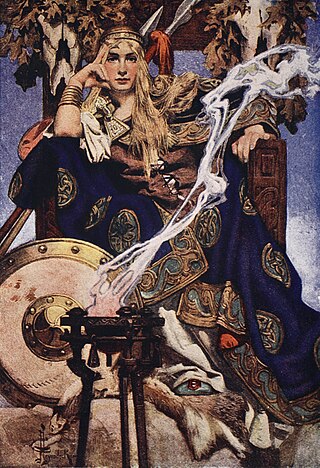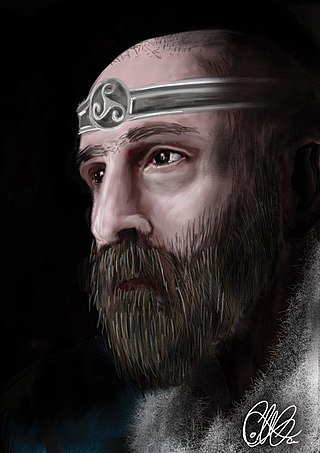Conchobarmac Nessa is the king of Ulster in the Ulster Cycle of Irish mythology. He rules from Emain Macha. He is usually said to be the son of the High King Fachtna Fáthach, although in some stories his father is the druid Cathbad, and he is usually known by his matronymic, mac Nessa: his mother is Ness, daughter of Eochaid Sálbuide, King of Ulster.
Cú Roí mac Dáire is a king of Munster in the Ulster Cycle of Irish mythology. He is usually portrayed as a warrior with superhuman abilities and a master of disguise possessed of magical powers. His name probably means "hound of the plain/field", or more specifically, "hound of the battlefield". He is the son of Dáire mac Dedad, and thus belongs to the Clanna Dedad. However, T. F. O'Rahilly believed this to be artificial, stating that "Cú Roí and Dáire are ultimately one and the same".

Cú Chulainn, called theHound of Ulster, is a warrior hero and demigod in the Ulster Cycle of Irish mythology, as well as in Scottish and Manx folklore. He is believed to be an incarnation of the Irish god Lugh, who is also his father. His mother is the mortal Deichtine, sister of king Conchobar mac Nessa.

Fergus mac Róich is a character in the Ulster Cycle of Irish mythology. Formerly the king of Ulster, he is tricked out of the kingship and betrayed by Conchobar mac Nessa, becomes the ally and lover of Conchobar's enemy, queen Medb of Connacht, and joins her expedition against Ulster in the Táin Bó Cúailnge. Fergus is described as being of huge size and sexual potency. This leads him into many a precarious situation as in the story of the Táin Bó Flidhais.

Medb, later spelled Meadhbh, Méibh and Méabh, and often anglicised as Maeve, is queen of Connacht in the Ulster Cycle of Irish mythology. Her husband in the core stories of the cycle is Ailill mac Máta, although she had several husbands before him who were also kings of Connacht. She rules from Cruachan. She is the enemy of Conchobar mac Nessa, king of Ulster, and is best known for starting the Táin Bó Cúailnge to steal Ulster's prize stud bull Donn Cúailnge.

Ailill mac Máta is the king of the Connachta and the husband of queen Medb in the Ulster Cycle of Irish mythology. He rules from Cruachan.

Táin Bó Cúailnge, commonly known as The Táin or less commonly as The Cattle Raid of Cooley, is an epic from Irish mythology. It is often called "The Irish Iliad", although like most other early Irish literature, the Táin is written in prosimetrum, i.e. prose with periodic additions of verse composed by the characters. The Táin tells of a war against Ulster by Queen Medb of Connacht and her husband King Ailill, who intend to steal the stud bull Donn Cuailnge. Due to a curse upon the king and warriors of Ulster, the invaders are opposed only by the young demigod, Cú Chulainn.

The Ulster Cycle, formerly known as the Red Branch Cycle, is a body of medieval Irish heroic legends and sagas of the Ulaid. It is set far in the past, in what is now eastern Ulster and northern Leinster, particularly counties Armagh, Down and Louth. It focuses on the mythical Ulster king Conchobar mac Nessa and his court at Emain Macha, the hero Cú Chulainn, and their conflict with the Connachta and queen Medb. The longest and most important tale is the epic Táin Bó Cúailnge. The Ulster Cycle is one of the four 'cycles' of Irish mythology and legend, along with the Mythological Cycle, the Fianna Cycle and the Kings' Cycle.
Mesca Ulad is a narrative from the Ulster Cycle preserved in the 12th century manuscripts the Book of Leinster and in the Lebor na hUidre. The title Mesca Ulad occurs only in the Book of Leinster version. The story is set during Samhain, and follows the Ulaid as they attempt to attend two feasts in the same night: the first at Dún Dá Bhenn to the north, and the second at Cúchulainn's fortress in Dún Delgan to the east. The men become intoxicated at the first feast and head south towards Kerry by accident. In Kerry, they are shown false hospitality by their traditional enemies the Munstermen, who offer them a place to stay. The Ulaid accept, and the Munstermen light a bonfire beneath the wood and iron structure. The Ulaids survive.
Eochu or Eochaid Feidlech, was a High King of Ireland, according to medieval Irish legends and historical traditions. He is best known as the father of the legendary queen Medb of Connacht.
Findabair or Finnabair was a daughter of Ailill and Queen Medb of Connacht in Irish mythology. The meaning of the name is "white phantom". The Dindsenchas also mention a Findabair who is the daughter of Lugaid Laigde.
Lugaid Riab nDerg or Réoderg, son of the three findemna, triplet sons of Eochu Feidlech, and their sister Clothru was, according to medieval Irish legend and historical tradition, a High King of Ireland.
Flidas or Flidais is a female figure in Irish Mythology, known by the epithet Foltchaín. She is believed to have been a goddess of cattle and fertility.
Fedelm is a female prophet and fili, or learned poet, in the Ulster Cycle of Irish mythology. She appears in the great epic Táin Bó Cuailnge, in which she foretells the armies of Medb and Ailill mac Máta will face against the Ulaid and their greatest champion, Cú Chulainn. A prophetess of the same name appears in another tale, which associates her with Cú Chulainn.
Mac Cécht is the patronymic or cognomen given to one or two warrior champions from Connacht in the Ulster Cycle of early Irish literature. The personages may be identifical or may have been conflated at some stage, although the connection is nowhere made explicit and different fathers are ascribed to them in the tales.
Amergin mac Eccit is a poet and warrior in the court of Conchobar mac Nessa in the Ulster Cycle of Irish mythology. He was the son of Eccet Salach, a smith, and grew to the age of fourteen without speaking or washing himself. One day Athirne, the Ulaid's chief poet, sent his servant to Eccet to order an axe. The servant was shocked when Amergin uttered a precocious, cryptic poem, and ran home to tell his master what he had heard.
The Dáirine, later known dynastically as the Corcu Loígde and associated, were the proto-historical rulers of Munster before the rise of the Eóganachta in the 7th century AD. They were derived from or closely associated with the Darini of Ptolemy and were also related to the Ulaid and Dál Riata of Ulster and Scotland. Their ancestors appear frequently in the Ulster Cycle. In historical times the Dáirine were represented, as stated, by the Corcu Loígde, the Uí Fidgenti and Uí Liatháin, as well as a few other early historical kindreds of both Munster and Ulster. In ancient genealogical schemes, the historical Dál Fiatach of Ulaid also belong to the Dáirine.
Dáire is an Old Irish name which fell out of use at an early period, remaining restricted essentially to legendary and ancestral figures, usually male. It has come back into fashion since the 18th century. The anglicised form of this name is Dara.
Clothru was, according to medieval Irish legend, the daughter of Eochu Feidlech, a High King of Ireland, and the sister of queen Medb of Connacht and Ethniu. When her triplet brothers, the findemna, were fighting with their father Eochu Feidlech for the high kingship, she was concerned that her brothers might die without heirs. She is said to have seduced the three of them, and conceived Lugaid Riab nDerg. The next day, according to legend, her brothers were indeed killed, and when Lugaid was born, he was their heir. His epithet Riab nDerg came from two red stripes around his neck and waist, dividing him into three: above the neck he resembled Nár; from the neck to the waist he resembled Bres; and from the waist down he resembled Lothar. Lugaid later also became a High King of Ireland, thus Clothru's incest preserved the line of succession. Incest features further in Clothru's story: she is said to have then slept with Lugaid herself, conceiving Crimthann Nia Náir, who later also became a High King of Ireland. She was thus Crimthann's mother, aunt and grandmother.





